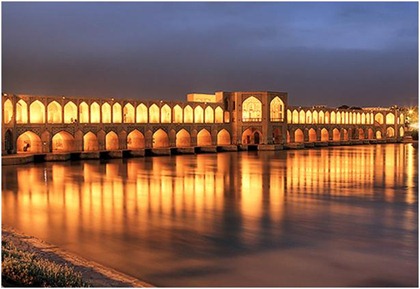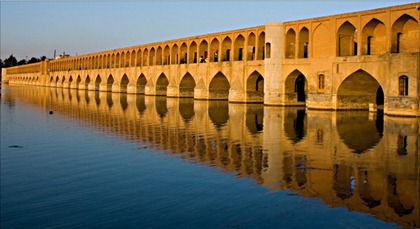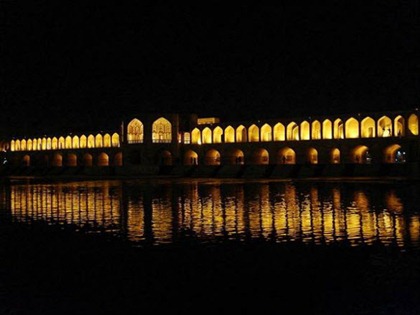The Khaju Bridge in Isfahan, Iran, was built in the 17th century by Shah Abbas II. The bridge also serves as a dam, with sluice gates under the archways.
Khaju Bridge is arguably the finest bridge in the province of Isfahan, Iran. It was built by the Persian Safavid king, Shah Abbas II around 1650 C.E., on the foundations of an older bridge. Serving as both a bridge, and a dam (or a weir), it links the Khaju quarter on the north bank with the Zoroastrian quarter across the Zayandeh River. Although architecturally functioning as a bridge and a weir, it also served a primary function as a building and a place for public meetings.
This structure originally was ornate with artistic tile works and paintings serving as a teahouse; In the centre of the structure, a pavilion exists inside of which Shah Abbas would have once sat, admiring the views. Today remnants of a stone seat is all that remains of the king's chair.
This bridge highlights one of the finest examples of Persian architecture at the height of Safavid cultural influence in Iran. In words of Upham Pope and Jean Chardin, Khaju bridge is "the culminating monument of Persian bridge architecture and one of the most interesting bridges extant...where the whole has rhythm and dignity and combines in the happiest consistency, utility, beauty, and recreation."
Khaju Bridge has 23 arches and is 105 metres long and 14 metres wide. The pass way of the bridge is 7.5 meters wide, made of bricks and stones with 21 larger and 26 smaller inlet and outlet channels. The pieces of stone used in this bridge are over 2 meters long and the distance between every channel and the ceiling base is 21 meters. The existing inscriptions suggest that the bridge was repaired in 1873.
Khaju is one of the bridges that regulate the water flow in the river because there are sluice gates under the archways over the river. When the sluice gates are closed, the water level behind the bridge is raised to facilitate the irrigation of the many gardens along the river upstream of this bridge













No comments:
Post a Comment